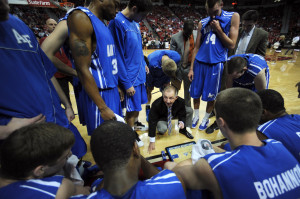Changing Basketball Playing Positions
So you starting coaching a basketball team and you realise you don’t have one of the playing positions covered. As a coach this is always of concern when evaluating your teams starting line-up. This will also play a part in the overall selection of the team and your squads final make-up. But what can you do as a coach when you are faced within this dilemma? Outside or recruiting players into the program to fill spots you do have a number of other options.

The first point to remember in these situations is that there are a myriad of different offensive strategies which can cater for a shortage of almost any playing position. Seeking out the best possible offensive structure will be important in making the most of your team’s strengths rather than focusing on your team’s weaknesses. Changing the offensive structure you are looking to use will allow you to hide some of the weaknesses you might have discovered.
Some offensive systems will require two post players, others only require one, and some don’t require a post player at all. If you don’t have a player in certain playing positions then try to find an offensive system that can still work for you or even serve to make you a hard to guard team for your opposition. For example teams with a lack of height often turn to high intensity defence played in the full court because they are more mobile.
Another consideration is moving players between positions to compensate for the missing piece in your team’s paying roster. There are playing positions within a basketball team structure that can easily be moved between to lower the impact on the overall performance of a void in the line-up. Two positions which can be rotated between are the playing positions of Centre and Power Forward. These two positions share a lot of similarities. Most players within these positions are good post players with strong rebounding capabilities. The players who often fill these positions share similar physical capabilities. In situations the differences between a Centre and Power Forward are limited to height and foot speed.
Two of the other playing positions which are highly interchangeable are the Small Forward and Shooting Guard playing positions. Both of these players have a very similar range of roles and responsibilities within many team offenses and defences. An example of this can be seen in transition where these positions often fill identical roles. This is also seen in half court offences where both positions often start on the perimeter balancing the spacing around the Point Guard. One distinct difference is the rebounding responsibilities of many Small Forwards who take part in the rebounding systems of teams.
The other possible rotation of playing positions can occur between the Shooting Guard and Point Guard. Many Shooting Guards are often referred to as combo guards because they display the ball handling skills needed to be a Point Guard on the floor. This is the hardest rotation to make however because of the specific requirements of the Point Guard position. Point Guards by the nature of what they do are often the player with the highest basketball IQ on the floor which assists with the needs of running the offense and being an extension of the coach during the on court action. For the rotation to work in these two positions the Shooting Guard must have the skills necessary to be able to fill the role of the Point Guard.
If you find that the rotation process is your option of choice you will need to be very proactive in focusing in providing individual training sessions for the technical skills necessary for the player transitioning between roles. The more opportunity you can give a player in their preparation time leading into the competitive games situations the better. To assist with this transition also look to have an Assistant Coach or a player assist with giving ongoing feedback about the standard of play to the athlete in the new position.
Defensively there are a number of situations that will be utilised by opposing teams to try and exploit mismatches in a team playing line-up. The key to success in dealing with these situations is to be prepared. For a team that has a weakness in any playing position must scout heavily your opposition to see where and when issues are likely to occur. Scouting opposition teams will not only identify individual match-ups that will be a problem, but how this advantage is likely to be exploited. By having in advance this information a team can drill counter tactics to nullify or at least minimise these possible challenges.
Considering all the possible options for countering issues in playing positions will give teams a range of possibilities, not just the quickest or easiest solution. There is nothing wrong with teams looking at a range of possible options and trialling different solutions before choosing the most favourable.







